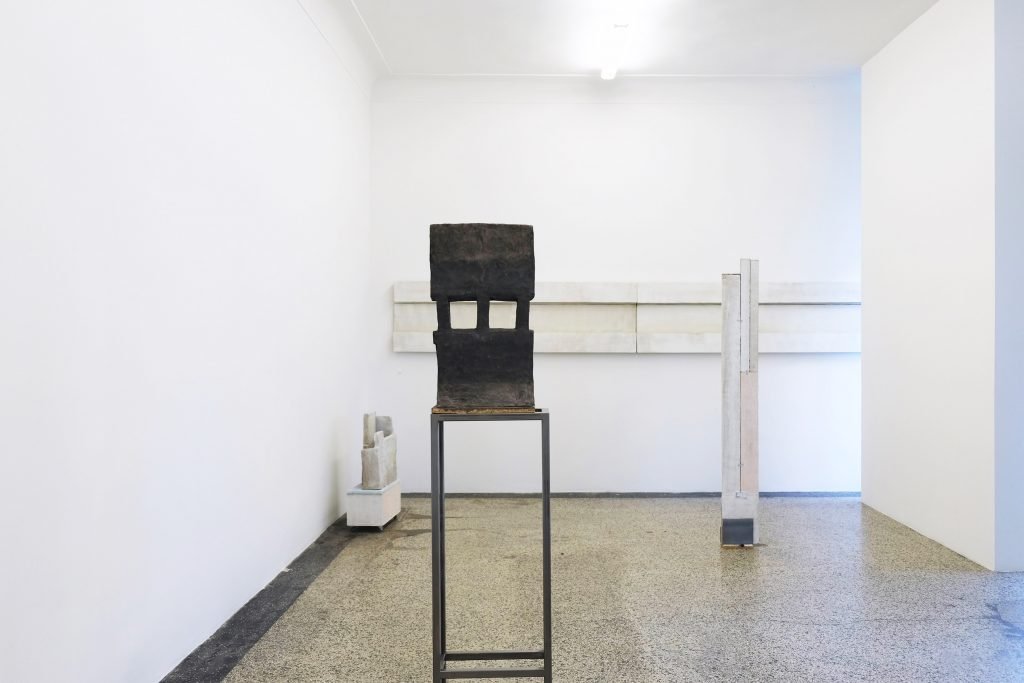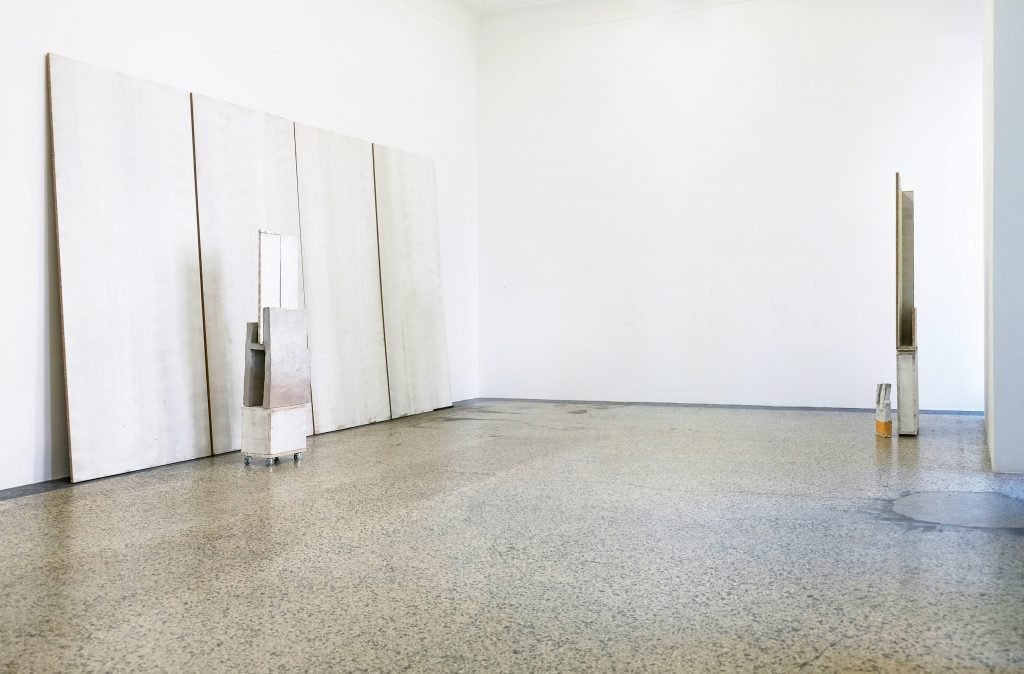
Ulrike Schulze
4 Sep. – 24 Oct. 2020
ULRIKE SCHULZE
SPECTRE
04 SEP.
24 OCT. 2020
Deconstructed catchment areas
by Larissa Kikol
White, concrete, sometimes black and crayon. A flair of minimal brutalism emerges, but at the same time it lives through its own deconstruction. The fact that appearances do not apply here, and never should, can be seen in Schulze’s idiosyncratic ‘bad perfection’, a conceptual, but also ironic continuation of the Minimal aesthetic into the present.
The sculptures are not figurative in any of their parts, yet one encounters them. Among them are broad counterparts, they assert volume, give mass, at least from a certain side, but turn out to be thin pretenders.
A bizarre, almost comical psychological component lies in them. They relate to the viewer, their individual parts relate to themselves. But they do not “match”. The pieces seem to fit only at first glance. An apparent coming together is repeatedly broken by crooked approaches. They fail halfway and yet they stand together.
But are these not rather games of architecture? Models of houses that are reluctant to be realized from the beginning? “For me they are also catchment areas,” remarks Schulze. Area does not mean house, but it can mean a more abstract variant of dwelling. The move-in can be carried out by imaginary inhabitants. The thought comes to mind when you look at the one or other gate at the foot of the sculptures. A Minimal-Art world of the house mouse Jerry? Here at the foot the sculpture already makes a decision. A closed gate leads to the potential catchment area. Other works show a smaller hollow space. “Feet” for Schulze. In this case, there is no move-in here, but a counterpart. The completion of a sculpture towards the floor is an essential moment that defines the work. Not only for a counterpart, but also for an object or architecture, is the closure, the base, the foundation, a decisive component for the perception of the complete contour and the assertion in space.
At first it seems as if Schulze’s sculptures were created spontaneously and quickly. In reality, she likes to take her time, observing and rethinking spontaneity very carefully.
Waiting is just as important a working process as the laying on of hands. Because only if you lie in wait in the woods long enough you do have the chance to perceive the emergence of phenomena. When Schulze lies in wait in front of her sculptures, it is not to force their form, but to recognize what the object contains and how it reacts with its surroundings or other objects. A lot happens while waiting. Important insights arise from this, which are then worked out again in more active processes.
Her works should not look beautiful. The implementation of ‘good ideas’ is not her concern, which is why Schulze does not make plans. Good ideas are platforms through which someone can present themselves in a particularly advantageous way. This is not her approach. She also turns away from “good taste”. The ‘bad perfection’ shares archaic moments of the open work of art. Instead of a refined finalization, the sculptures retain a character of processuality and authentic momentary realism.
Therefore Schulze often works with raw chipboard – her standard wood. Raw chipboard emerges when wood chips are pressed into solid boards with binders under pressure and heat. They are robust and can withstand a lot. They are not elegant though. What Arte Povera accomplished in the post-war period, namely the self-confident rejection of elitist, luxurious artistic materials, has continued through the DIY store aura in recent decades. But the materials bought there today only refer to themselves. They no longer assume political, social or unconscious representations. They stand neither for a material theory nor for a questioning of themselves. They serve the artist and ultimately their own haptic essence.
Other sculptures look like concrete. An illusion, because in reality they are painted ceramics. First they shine grey, mixed with veils of color, sometimes reddish or sometimes purple-turquoise. There are traces of casein, acrylic, wax crayons or chalk. The purple-turquoise reminds of ski jackets of the 90s. The reddish painted sculpture bears the name Appaloosa Mare, saddled. The animation of non-representational things is called Animism in psychology. Jean Piaget coined the term childlike Animism in 1926. Unanimated objects, even as far removed from human or animal life as a stone, attain animation in the child’s perception. The ceramic in a concrete coat becomes a mare.
But what happens formally to the sculptures? Around them, on them? Not much at first. They seem to be looked at quickly. But a short stop in front of them is delayed. Because if no one sings loudly, the bizarre humming from the background suddenly sounds all the stronger. But the hum does not come from a single source of noise. One is the trace of crayon. Other disturbances arise from edges that do not come together. Even a certain obliquity jumps at the restless viewer. The hold lasts longer.
Straight surfaces end abruptly before their apparent destination. On the back of U lies a thin ceramic disk. It does not quite fit. Here, the sculpture ends and at the same time opens into the room. If it would fit, the opening would be closed.
And what about the crayon? It denotes a side view, the thinness of the pretended. When you look around the corner, you discover a crooked yellow square and another one with two triangles. Scribbled out. It hums.
Schulze’s sculptures can be understood as opposition to Bauhaus art. Their understanding of a mastery of form is negated from the beginning. For Schulze, beauty and functionality under the auspices of an art turned towards the human being would mean mistakes. Although building plays an essential role in her approach, but rather so as a way of overcoming reconciliation – instead, she builds on a raw, sometimes humorous autonomy of the non-connoted form. The catchment area is strained, it lights up and disappears as soon as the spatial perspective changes.
ULRIKE SCHULZE | GALLERY EXHIBITIONS

4 Sep. – 24 Oct. 2020

5 May – 29 Jul. 2018